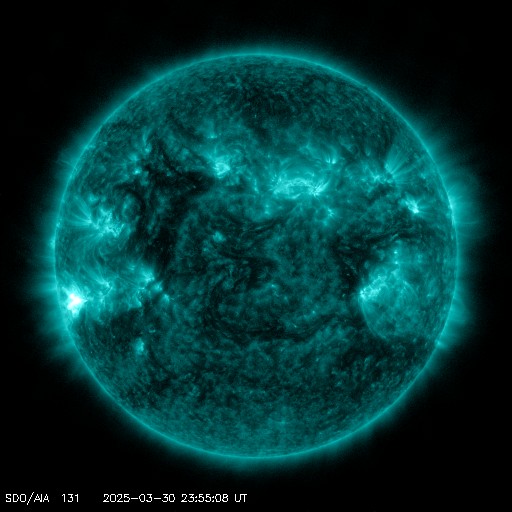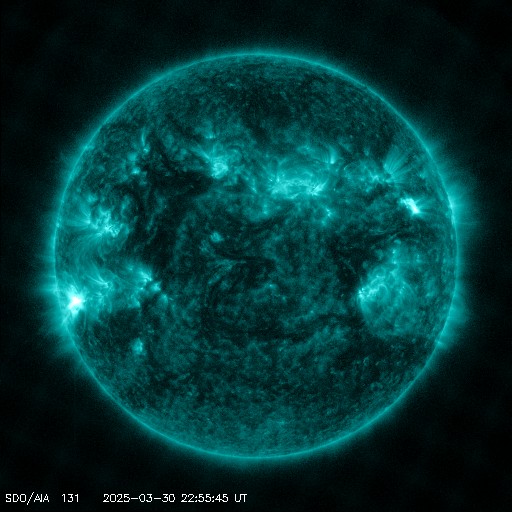Viewing archive of Saturday, 6 August 2011
Solar activity report
Any mentioned solar flare in this report has a scaling factor applied by the Space Weather Prediction Center (SWPC). Because of the SWPC scaling factor, solar flares are reported as 42% smaller than for the science quality data. The scaling factor has been removed from our archived solar flare data to reflect the true physical units.
Report of Solar-Geophysical Activity 2011 Aug 06 2200 UTCPrepared by the NOAA © SWPC and processed by SpaceWeatherLive.com
Joint USAF/NOAA Report of Solar and Geophysical Activity
SDF Number 218 Issued at 2200Z on 06 Aug 2011IA. Analysis of Solar Active Regions and Activity from 05-2100Z to 06-2100Z
Solar activity was low. The largest event of the
period was a C4/Sf flare from Region 1267 (S17E13). This region
developed a small delta in the central spot. Region 1263, an Ekc
spot class with a Beta-Gamma-Delta magnetic configuration, lost some
penumbral area in its central spots, however it developed new spots
as flux began to emerge from its trailer area. SOHO/LASCO C2
imagery observed two slow moving CMEs at 1036Z and 1736Z with the
majority of the ejecta directed off the West limb. SDO and SXI
imagery showed filament eruptions associated with the events. These
CMEs are not expected to be geoeffective.
IB. Solar Activity Forecast
Solar activity is expected to be low
with the continued chance for an M-class flare from Region 1263.
IIA. Geophysical Activity Summary 05-2100Z to 06-2100Z
The geomagnetic field was at quiet to severe storm levels. Minor to
severe storm periods were seen from 05/2100Z to 06/0600Z. The
period started off with solar wind speeds reaching approximately 620
km/s with a total field strength around 28 nT. The Bz component of
the magnetic field was south around -20 nT for 2 hours before
crossing into a positive region at approximately 05/2211Z. Solar
wind speed, density, and total magnetic field strength slowly
decreased throughout the period as the effects of the CME passage
began to diminish. The period ended with a wind speed around 440
km/s and Bt around 5 nT. The greater than 10 MeV protons above 10
PFU event that began at 04/0635Z, reached a peak flux of 96 PFU at
05/2150Z, and ended at 06/0515Z.
IIB. Geophysical Activity Forecast
The geomagnetic field is
expected to be unsettled to active on 07 August as a recurrent
coronal hole high speed stream is expected to become geoeffective.
Levels are expected to decrease to quiet to unsettled on 08 August.
Mostly quiet conditions are expected on 09 August.
III. Event Probabilities 07 Aug to 09 Aug
| Class M | 45% | 45% | 35% |
| Class X | 10% | 10% | 05% |
| Proton | 10% | 10% | 05% |
| PCAF | green | ||
IV. Penticton 10.7 cm Flux
Observed 06 Aug 110 Predicted 07 Aug-09 Aug 105/100/095 90 Day Mean 06 Aug 096
V. Geomagnetic A Indices
Observed Afr/Ap 05 Aug 032/049 Estimated Afr/Ap 06 Aug 018/033 Predicted Afr/Ap 07 Aug-09 Aug 015/015-008/010-005/005
VI. Geomagnetic Activity Probabilities 07 Aug to 09 Aug
| A. Middle Latitudes | |||
|---|---|---|---|
| Active | 25% | 10% | 05% |
| Minor storm | 15% | 05% | 01% |
| Major-severe storm | 05% | 01% | 01% |
| B. High Latitudes | |||
|---|---|---|---|
| Active | 25% | 15% | 05% |
| Minor storm | 20% | 05% | 01% |
| Major-severe storm | 15% | 01% | 01% |
All times in UTC
Current data suggests there is a slight possibility for aurora to appear at the following high latitude regions in the near future
Yellowknife, NTFairbanks, AK
Latest news
Latest forum messages
Solar Demon 3Unspecified geomagnetic activity 2146AR4046 134Aurora photography hints for those of us with smartphones 54AR4048 34
More topicsSupport SpaceWeatherLive.com!
A lot of people come to SpaceWeatherLive to follow the Sun's activity or if there is aurora to be seen, but with more traffic comes higher server costs. Consider a donation if you enjoy SpaceWeatherLive so we can keep the website online!

Latest alerts
00:09 UTC - Solar flare
Moderate M1.03 flare
Sunday, 30 March 2025
23:51 UTC - Radio Blackout
Minor R1 radio blackout in progress (≥M1 - current: M1.03)
23:39 UTC - Solar flare
Moderate M1.52 flare
23:21 UTC - Radio Blackout
Minor R1 radio blackout in progress (≥M1 - current: M1.49)
23:09 UTC - Solar flare
Moderate M1.48 flare
Space weather facts
| Last X-flare | 2025/03/28 | X1.1 |
| Last M-flare | 2025/03/30 | M1.0 |
| Last geomagnetic storm | 2025/03/27 | Kp5 (G1) |
| Spotless days | |
|---|---|
| Last spotless day | 2022/06/08 |
| Monthly mean Sunspot Number | |
|---|---|
| February 2025 | 154.6 +17.6 |
| March 2025 | 127 -27.6 |
| Last 30 days | 127 -25.7 |





